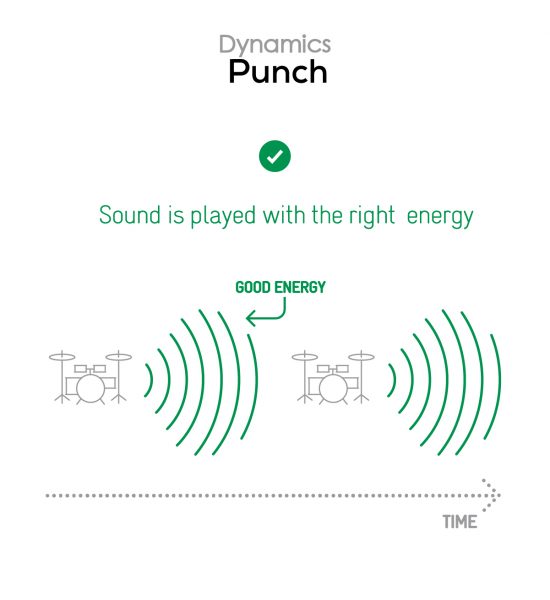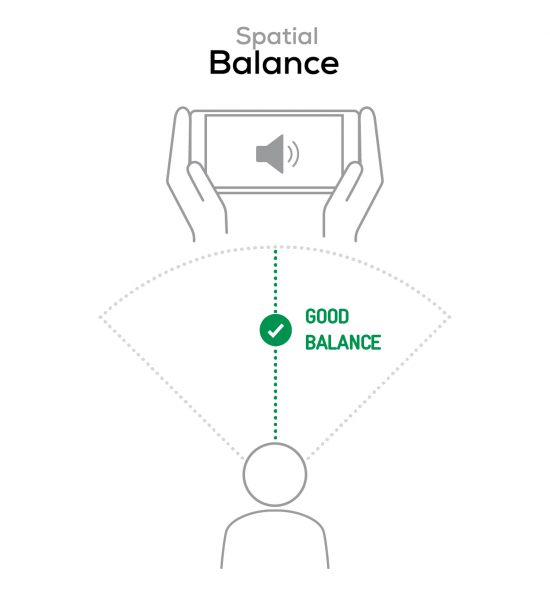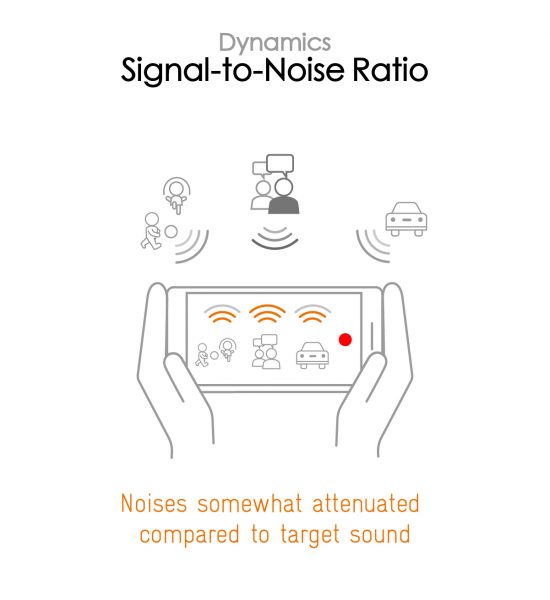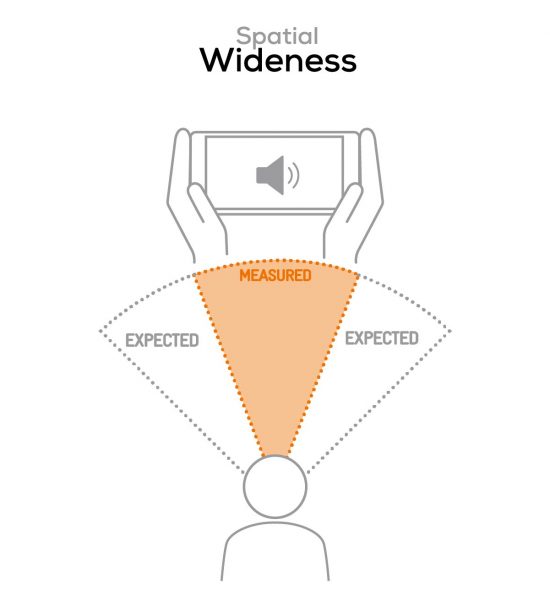We put the Google Pixel 8 Pro through our rigorous DXOMARK Audio test suite to measure its performance both at recording sound using its built-in microphones, and at playing audio back through its speakers.
In this review, we will break down how it fared in a variety of tests and several common use cases.
Overview
Key audio specifications include:
- Two speakers (Top center, bottom right)
- No Jack audio output
Scoring
Sub-scores and attributes included in the calculations of the global score.
Google Pixel 8 Pro


 14th
14th 9th
9thPlayback
Cons
- Tonal balance lacks clarity at soft and nominal volumes
- Timbre and dynamics impaired by distortion at maximum volume
Recording
Pros
- Very natural and pleasant timbre
- Good spatial performance
- Unwanted artifacts well under control
With a DXOMARK Audio score of 142, the Google Pixel 8 Pro performed very well in our tests and is a clear improvement over its predecessor, the Pixel 7 Pro, with better results in both playback and recording. The built-in speakers sounded great, with a warm timbre and excellent wideness of the sound scene. In playback, the device did best when listening to music. Audio quality was good when watching movies or gaming as well, but the test scores were slightly lower for those use cases.
Pixel 8 Pro audio recordings featured a pleasant and natural timbre. Our testers found that the recording quality during loud events in particular, such as concerts, had been improved over the previous generation Google flagship. The audio zoom feature could have been more effective, though. Recording results were best when using the front camera but only slightly lower with the main camera app. Due to its mono rendition, there was a noticeable drop in performance when using the recorder app for memos and similar use.
Test summary
About DXOMARK Audio tests: For scoring and analysis in our smartphone audio reviews, DXOMARK engineers perform a variety of objective tests and undertake more than 20 hours of perceptual evaluation under controlled lab conditions.
(For more details about our Playback protocol, click here; for more details about our Recording protocol, click here.)
The following section gathers key elements of our exhaustive tests and analyses performed in DXOMARK laboratories. Detailed performance evaluations under the form of reports are available upon request. Do not hesitate to contact us.
Playback
Google Pixel 8 Pro
163
DXOMARK engineers test playback through the smartphone speakers, whose performance is evaluated in our labs and in real-life conditions, using default apps and settings.

Timbre
Google Pixel 8 Pro
158
The Timbre score represents how well a phone reproduces sound across the audible tonal range and takes into account bass, midrange, treble, tonal balance, and volume dependency. It is the most important attribute for playback.
In our playback tests, the Pixel 8 Pro delivered a decent overall timbre performance, despite a flawed tonal balance. The upper part of the spectrum lacked brightness and clarity, and treble sounded slightly dull. The results of the perceptual evaluation were confirmed by the frequency response graph, which showed a lack of treble, especially a lack of upper treble strength and high-end extension. Midrange was pleasantly warm, though, despite a slight lack of information below 600Hz. This warmth was ideal for the rendition of vocal content and music. However, our testers noted a general lack of clarity.
Our experts found the low end to be overall strong and pleasant, but an emphasis on upper bass meant that the lower section tended to be overpowered. This resulted in a perceived lack of depth. Depending on content, the tonal balance could sound slightly boomy or boxy. But most of the time it sounded slightly dull or dark.
At soft volumes, the testers found the lack of treble to become more noticeable, while at the maximum volume setting, upper midrange became slightly too prominent, with the tonal balance sounding aggressive as well. It’s worth noting that when playing games the tonal balance was surprisingly different to music and movie apps. The muffled sound was gone, but there was still a lack of bass and low midrange.

Dynamics
Google Pixel 8 Pro
149
The Dynamics score measures the accuracy of changes in the energy level of sound sources, for example how precisely a bass note is reproduced or the impact sound from drums.
The dynamics performance was good overall. Attack was decent but lacked sharpness and could have been snappier. This was exacerbated by a lack of information in the upper spectrum. At maximum volume, our testers found attack to be impaired by significant distortion, crushing transients. Bass precision was good overall, with accurate attack of the bass. However, sustain and release could have been more consistent. Both were impaired by resonances and had a tendency to sound slightly exaggerated. Punch was very good on the other hand, thanks to satisfying low midrange energy. At the maximum volume setting, the focus on upper midrange caused a loss of energy in the rest of the spectrum, particularly low midrange. This resulted in a less punchy rendition.



Spatial
Google Pixel 8 Pro
162
The sub-attributes for spatial tests include pinpointing a specific sound's location, its positional balance, distance, and wideness.
In our tests, the Pixel 8 Pro delivered good spatial results overall. Wideness of the projected sound scene was particularly good, thanks to an immersive stereo image that reached beyond the physical borders of the device. Our testers found the distance rendition to be accurate and balance well-centered. However, the localizability of individual sound sources in the scene was slightly blurry, mainly due to inconsistent treble rendition. Depth rendition could also have been better as it sounded a little flat, with little distance difference being perceived between distinct sound sources.



Volume
Google Pixel 8 Pro
162
The Volume score represents the overall loudness of a smartphone and how smoothly volume increases and decreases based on user input.
During the volume tests, our audio experts found the Pixel 8 Pro’s maximum volume setting to be loud enough and the volume steps to be evenly distributed. However, the minimum was too quiet, making it difficult to hear the soft volume sections in highly dynamic content, such as classical music. It’s also worth noting that the difference in tuning between the music app and games also resulted in a difference in volume steps.
Here are a few sound pressure levels (SPL) measured when playing our sample recordings of hip-hop and classical music at maximum volume:
| Hip-Hop | Classical | |
| Google Pixel 8 Pro | 74.3 dBA | 71.4 dBA |
| Apple iPhone 15 Pro Max | 75.1 dBA | 72.3 dBA |
| Samsung Galaxy S23 Ultra | 74.8 dBA | 71.8 dBA |

Artifacts
Google Pixel 8 Pro
157
The Artifacts score measures the extent to which the sound is affected by various types of distortion. The higher the score, the less the disturbances in the sound are noticeable. Distortion can occur because of sound processing in the device and because of the quality of the speakers.
At maximum volume, our testers noticed some excessive compression and found timbre and dynamics to be impaired by distortion. On the plus side, the Pixel 8 Pro was designed in a way that makes it unlikely for the speakers to be covered by the user’s fingers when gaming.


It represents the distortion and noise of the device playing our test signal (0 dB Fs, Sweep Sine in an anechoic box at 40 cm) at the device's maximum volume.
Recording
Google Pixel 8 Pro
160
DXOMARK engineers test recording by evaluating the recorded files on reference audio equipment. Those recordings are done in our labs and in real-life conditions, using default apps and settings.

Timbre
Google Pixel 8 Pro
147
The Timbre score represents how well a phone captures sounds across the audible tonal range and takes into account bass, midrange, treble, and tonal balance. It is the most important attribute for recording.
During the recording tests, the Google device delivered very good results in terms of timbre, with a natural and pleasant tonal balance that was consistent across all tested camera and recording apps. However, some parts of the frequency spectrum, such as treble and low midrange, showed some imperfections.
Treble rendition was overall natural, despite a noticeable lack of brightness, which was caused by insufficient upper treble and a somewhat limited high-end extension. These deficiencies appeared to be most noticeable when recording with the main camera. This said, high-end extension sounded particularly limited on recordings made with the memo app. In both apps, a lack of information was noticeable between 3-4kHz.
Midrange had good clarity across all use cases, but lacked strength and body around 200Hz. This was particularly noticeable on some of the male voices in our test scenarios. Otherwise, rendition was quite satisfying, without any particular resonance. Bass rendition lacked a little strength overall, and particularly low-end extension. The results were still satisfying, but the lack of strength mentioned above, in combination with a slightly weak low midrange, resulted in a slightly thin tonal balance.
When recording loud concerts with the main camera, tonal balance was good overall, with sufficient bass rendition and low-end extension. The lower region could be a bit boomy though. Midrange slightly lacked presence, as well as a little clarity. Treble was slightly dull, and lacked brightness overall.

Dynamics
Google Pixel 8 Pro
146
The Dynamics score measures the accuracy of changes in the energy level of sound sources, for example how precisely a voice's plosives (the p's, t's and k's, for example) are reproduced. The score also considers the Signal-to-Noise Ratio (SNR), for example how loud the main voice is compared to the background noise.
Recording dynamics performance was good. Envelope was accurate, with a realistic rendition across use cases. However, attack lacked sharpness in general, and in particular in vocal use cases where plosives sounded a little flat. When recording concerts, envelope was decent but affected by compression.
The signal-to-noise ratio was good across all use cases. The device applies some form of background reduction to its recordings which was quite subtle when recording with the main camera, but more obvious with the front camera. This said, when using the memo app in an urban environment, our testers noted that some quieter sentences could be drowned out by background noise.



Spatial
Google Pixel 8 Pro
159
The sub-attributes for spatial tests include pinpointing a specific sound's location, its positional balance, distance, and wideness on the recorded audio files.
The Pixel 8 Pro also did well in the spatial test category. Localizability of individual sound sources was very decent and wideness of the recorded sound scene was good, even though with the main camera it could have been even wider. This was true for all use cases except the recorder app, which is limited by its mono recordings. Distance rendition was good, too, but some voices could sound a little too distant.



Volume
Google Pixel 8 Pro
170
The Volume score represents how loud audio is normalized on the recorded files and the how the device handles loud environments, such as electronic concerts, when recording.
Our testers found the overall loudness of recordings to be average. Louder recordings would not have done any harm. The objective measurements showed good results, with great loudness levels and great resilience to high sound pressure levels, for example when recording loud events such as concerts.
Here are the sound levels recorded in the audio and video files, measured in LUFS (Loudness Unit Full Scale); as a reference, we expect loudness levels to be above -24 LUFS for recorded content:
| Meeting | Life Video | Selfie Video | Memo | |
| Google Pixel 8 Pro | -26.3 LUFS | -20.8 LUFS | -18.8 LUFS | -19.9 LUFS |
| Apple iPhone 15 Pro Max | -24.9 LUFS | -22.1 LUFS | -20.5 LUFS | -19.2 LUFS |
| Samsung Galaxy S23 Ultra | -26.5 LUFS | -21.8 LUFS | -22.4 LUFS | -21.6 LUFS |
The Artifacts score measures the extent to which the recorded sounds are affected by various types of distortions. The higher the score, the less the disturbances in the sound are noticeable. Distortions can occur because of sound processing in the device and the quality of the microphones, as well as user handling, such as how the phone is held.
Unwanted recording artifacts were overall well under control, but recordings of loud concerts were affected by compression. A peak in THD+n (Total Harmonic Distortion Plus Noise) was observable in lower treble, which coincided with a lack of information at high sound pressure levels in the same region of the spectrum. Like the speakers, microphones were not easily occluded, and finger noises were not an issue either.


In this audio comparison, you can listen to the way this smartphone handles wind noise relative to its competitors:

Background
Google Pixel 8 Pro
166
Background evaluates how natural the various sounds around a voice blend into the video recording file. For example, when recording a speech at an event, the background should not interfere with the main voice, yet it should provide some context of the surroundings.
Background performance was very good, without any unwanted artifacts. Background tonal balance was slightly focused on midrange, but the quieter low- and high-end helped the main signal stand out more. Background timbre was overall pleasant.





DXOMARK encourages its readers to share comments on the articles. To read or post comments, Disqus cookies are required. Change your Cookies Preferences and read more about our Comment Policy.